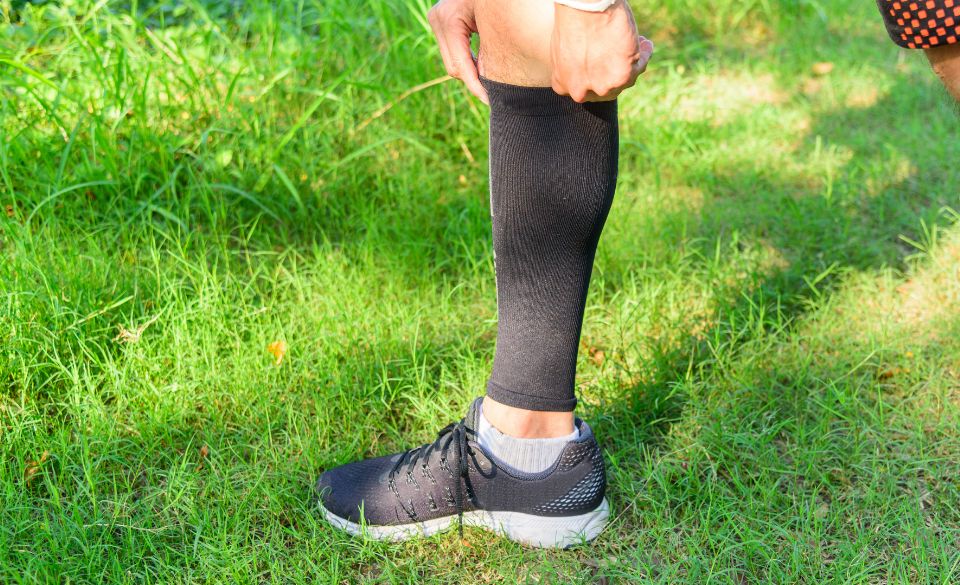
Why Do Runners Wear Calf Sleeves?
Page Contents
If you’ve ever seen runners hitting the pavement with compression sleeves on their calves, you may have wondered what purpose they serve. Calf sleeves, also known as compression sleeves, have become a popular accessory among runners of all levels. In this blog post, we’ll explore the reasons why runners choose to wear calf sleeves and delve into the scientific evidence behind their benefits. So, lace up your shoes and let’s uncover the mystery of calf sleeves!
The Science Behind Compression Sleeves
Before we dive into the specific benefits for runners, let’s understand how compression sleeves work. Compression garments, including calf sleeves, apply gentle pressure to the muscles and blood vessels in the targeted area. This compression helps improve blood circulation, reduces muscle vibration, and provides support to the muscles and tendons.
Numerous studies have investigated the effects of compression garments on athletic performance and recovery. A study published in the Journal of Strength and Conditioning Research found that wearing compression sleeves during exercise resulted in reduced muscle oscillation and perceived muscle soreness.
Another study published in the European Journal of Applied Physiology observed that compression garments enhanced blood flow and oxygen delivery to the muscles during exercise. This can lead to improved endurance, reduced muscle fatigue, and potentially enhanced performance.
Benefits for Runners
Now let’s explore the specific benefits of calf sleeves for runners:
Improved Circulation
During running, the calf muscles work vigorously, contracting and relaxing with each stride. Compression sleeves provide graduated compression, meaning they are tighter at the ankle and gradually loosen as they move up the leg. This compression helps enhance blood flow and oxygen delivery to the muscles, which can improve performance and delay fatigue.
Reduced Muscle Fatigue and Soreness
The repetitive impact and constant contraction of muscles during running can lead to muscle fatigue and soreness. Compression sleeves provide support to the calf muscles, reducing muscle vibration and minimizing the risk of micro-tears that contribute to muscle soreness. By minimizing muscle damage, runners may experience less post-run fatigue and a faster recovery.
Injury Prevention and Support
Calf sleeves can offer additional support to the calf muscles, tendons, and ligaments, potentially reducing the risk of common running injuries such as calf strains or Achilles tendonitis. The compression provided by the sleeves can stabilize the muscles and help maintain proper alignment, reducing the risk of overuse injuries.
Temperature Regulation
Calf sleeves can also provide a degree of thermal regulation. They help to retain heat during colder weather, keeping the calf muscles warm and preventing muscle stiffness. In warmer conditions, the moisture-wicking properties of some compression sleeves help to keep the legs dry and cool, enhancing overall comfort during the run.
Choosing and Wearing Calf Sleeves
When selecting calf sleeves, it’s important to choose the right size and compression level for your needs. Follow the manufacturer’s guidelines or seek advice from a specialty running store to ensure proper fit and compression. It’s also crucial to wear the sleeves correctly, pulling them up evenly and making sure they sit snugly but not too tight.
Calf sleeves are typically worn during running or other physical activities, but some runners may also choose to wear them during recovery periods to aid in muscle repair and reduce swelling. Experiment with wearing calf sleeves during your training runs to see if they provide the desired benefits for your specific needs.
Finding the Right Fit
When it comes to calf sleeves, finding the right fit is crucial for optimal performance and comfort. Follow these tips to ensure you choose the right size and fit for your calf sleeves:
1.Measure Your Calf: Use a measuring tape to measure the circumference of your calf at its widest point. Refer to the sizing chart provided by the manufacturer to determine the appropriate size based on your measurements.
2. Consider Compression Level: Calf sleeves come in different compression levels, typically ranging from mild to moderate. Mild compression sleeves provide a gentle squeeze, while moderate compression offers a tighter fit. Consider your personal preferences and needs when selecting the compression level.
3. Try Them On: If possible, try on different brands and sizes of calf sleeves to assess the fit and comfort. The sleeves should be snug but not excessively tight, and they should cover the entire calf muscle without rolling or bunching up.
4. Evaluate Material and Breathability: Look for calf sleeves made of breathable and moisture-wicking materials to keep your legs cool and dry during your runs. Pay attention to the fabric composition and choose a material that suits your preferences and climate conditions.
5. Read Reviews and Seek Recommendations: Reading customer reviews and seeking recommendations from other runners can provide valuable insights into the quality, durability, and performance of different calf sleeve brands.
Calf Sleeves as Part of Your Running Routine
To make the most of your calf sleeves, incorporate them into your running routine effectively:
1. Wear Them During Runs: Put on your calf sleeves before your runs, ensuring they are positioned properly and evenly on both calves. Experience the benefits of improved circulation, reduced muscle fatigue, and added support during your training sessions.
2. Post-Run Recovery: Consider wearing calf sleeves during your post-run recovery to aid in muscle repair and reduce swelling. The compression provided by the sleeves can help enhance the recovery process and alleviate muscle soreness.
3. Gradual Adaptation: If you’re new to wearing calf sleeves, allow your body time to adapt to them. Start with shorter runs and gradually increase the duration and intensity of your runs while wearing the sleeves. Listen to your body and adjust accordingly.
4. Wash and Care Instructions: Follow the manufacturer’s instructions for washing and caring for your calf sleeves. Proper maintenance will help maintain their compression and extend their lifespan.
The Personal Preference Factor
It’s important to note that while calf sleeves can offer potential benefits to runners, their effectiveness can vary from person to person. Some runners may find significant improvements in their performance and recovery, while others may not notice a substantial difference.
Ultimately, the decision to wear calf sleeves is a personal one. It’s worth giving them a try to see if they enhance your running experience and provide the desired benefits. Remember that calf sleeves are not a substitute for proper training, adequate rest, and overall healthy habits.
Conclusion
Calf sleeves have gained popularity among runners for their potential benefits in improving circulation, reducing muscle fatigue and soreness, providing injury prevention and support, and aiding in temperature regulation. While the scientific evidence on their effectiveness is still evolving, many runners find them beneficial and enjoy the added comfort and support they provide.
If you’re curious about calf sleeves and how they might enhance your running experience, consider giving them a try. Remember, everyone’s body is unique, so what works for one runner may not work for another. Listen to your body, experiment, and decide if calf sleeves are a valuable addition to your running gear.




